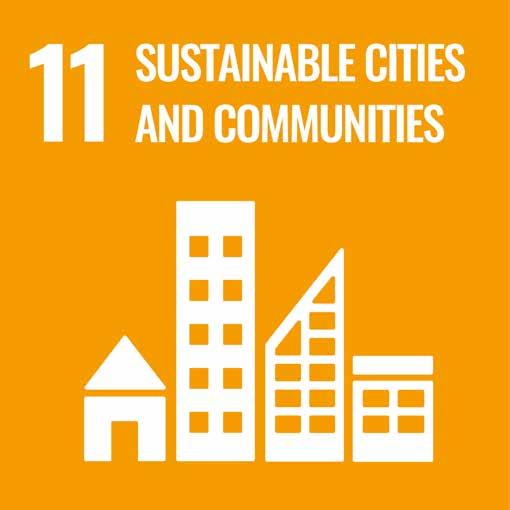
4 minute read
Glossary
ADAPTIVE REUSE – used about buildings where change occurs on the premises of the architecture that already exists, with original use or change of use. In contrast to transformation, which often involves changing the building structure, ”adaptive reuse” involves a fundamental idea of starting from the existing building structure, where the building forms the premises for its use.
ARCHAEOLOGICAL DEPOSITS – deposits accumulated through human activities.
CIRCULAR ECONOMY – a principle of systems and processes for maintaining the value of structures, products, materials and resources for as long as possible in a closed circuit, where the goal includes reducing waste and the need for new raw materials.
CLIMATE CHANGE ADAPTATION – understanding the consequences of climate change and taking measures to prevent or reduce damage while exploiting the opportunities such changes may entail.
CLIMATE PROJECTIONS – calculations of what the climate will look like in the future, based on climate models and earth system models. The models describe processes between oceans, air, land and earth using mathematical equations.
CULTURAL ENVIRONMENT – Any area where a cultural monument or site forms part of a larger entity or context. With White Paper 16 (2019–2020) New Goals in the Cultural Environment Policy – Engagement, Sustainability and Diversity, the Government introduced the term “cultural environment” as a collective term. It includes the terms “cultural monuments, sites, environments and landscapes” and is used to refer to the sector as a whole. CULTURAL HERITAGE –A collective term covering both tangible and intangible cultural heritage. Intangible cultural heritage refers to practices, representations, expressions, knowledge and skills. The term is frequently used in international contexts.
CULTURAL MONUMENT OR SITE – Traces of human activity in the physical environment, including places associated with historical events, beliefs and traditions.
ENERGY EFFICIENCY – measures that improve energy performance in buildings, constructions, vessels etc., to reduce their energy requirement.
ENERGY PERFORMANCE – the measurement of how efficiently energy is produced, distributed, stored, converted and used. Energy performance can also refer to environmental impact and cost.
GREENHOUSE GAS ACCOUNTING (FOR BUILDINGS) – a calculation of greenhouse gas emissions from materials and energy that are part of the entire life cycle of the building from development, operation and maintenance to demolition.
GREENHOUSE GAS EMISSIONS – emissions of gases to air that affect the atmosphere’s ability to retain heat, thus changing the climate. Carbon dioxide (CO2), methane (CH4) and nitrous oxide (N2O) are examples of greenhouse gases.
LANDSCAPE – An area, as perceived by people, whose character is the result of the action and interaction of natural and/or human factors.
LIVEABLE CITIES AND TOWNS – cities or places that are good to live in, that have surroundings that contribute to a high quality of life. Assessments of the degree of liveability include physical and non-physical indicators/ dimensions, including sports and culture, safety and health, education and learning, mobility, the physical environment, nature, urban life and urban spaces, identity and commercial activity.
PROTECTION – This is the strictest form of preservation, authorised by the Norwegian Cultural Heritage Act and the Svalbard Environmental Protection Act. Cultural monuments, sites and environments can all be protected, either automatically protected, protection through an individual protection order, protection through regulations or temporarily protected.
REUSE – the term ”reuse” is used here about buildings, building parts or materials reused in their original form. This may involve new use or unchanged use (with new users). See also ”adaptive reuse”.
RISK – in everyday use, the terms ”danger” and ”risk” are often used interchangeably. Even though a danger can potentially cause damage or destruction, a risk is the likelihood that such damage or destruction will occur under defined circumstances. In other words, risk can be described as the chance of something happening that will have negative consequences for cultural environments.
SCIENTIFIC VALUE – value attributed to cultural environments which are of particular importance as a source of knowledge and understanding of the past.
SUSTAINABLE DEVELOPMENT – development that satisfies current needs without compromising the chances of future generations being able to satisfy theirs. WORLD HERITAGE – Cultural heritage and/ or natural heritage that is inscribed on UNESCO’s List of World Heritage. The World Heritage properties form a common heritage of outstanding universal value to all humanity, across national borders.
WORTHY OF PROTECTION / WORTHY OF PRESERVATION – A cultural monument, site or cultural environment that has undergone a cultural-historical assessment and has been identified as worthy of preservation. Most cultural monuments, sites and environments deemed worthy of preservation are not formally protected pursuant to the Cultural Heritage Act, the Planning and Building Act or a binding agreement.
NOTES
1 Conventions concerning the cultural environment ratified by Norway: https://www.riksantikvaren.no/ arbeidsomrader/konvensjoner/ 2 https://whc.unesco.org/en/climatechange/ 3 Fufa S. M., Flyen, C. and Venås, C. (2020) Grønt er ikke bare en farge: Bærekraftige bygninger eksisterer allerede. SINTEF Fag 68. https://sintef.brage.unit.no/ sintef-xmlui/handle/11250/2719890 4 The European Commission (2020) Circular Economy
Action Plan For a cleaner and more competitive
Europe. https://eur-lex.europa.eu/legal-content/EN/
TXT/?qid=1583933814386&uri=COM:2020:98:FIN 5 Deloitte (2020) Kunnskapsgrunnlag for nasjonal strategi for sirkulær økonomi. Delutredning 1 – Potensial for økt sirkularitet. https://www.regjeringen.no/ contentassets/7ca1a81f57cc4611a193570e80c4dafd/ deloitte_kunnskapsgrunnlag-sirkular-okonomi_ potensialer.pdf 6 Fufa S. M., Flyen, C. and Venås, C. (2020) Grønt er ikke bare en farge: Bærekraftige bygninger eksisterer allerede. SINTEF Fag 68. https://sintef.brage.unit.no/ sintef-xmlui/handle/11250/2719890 7 Fortidsminneforeningen (2019) Bærekraftig klimaforbedring av eldre hus.
The Directorate for Cultural Heritage Post Box 1483 Vika, 0116 Oslo Visiting address / Dronningens gate 13, Oslo Tel. / 22 94 04 00 Email / postmottak@ra.no
Follow us on social media /








